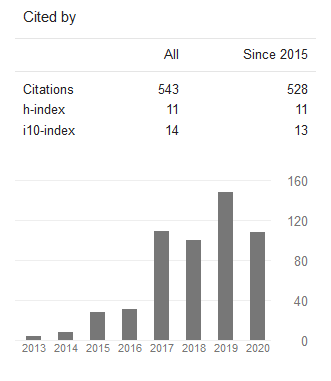Analisis Motivasi Hedonis Seseorang Dalam Menggunakan Media Sosial: Studi Kasus Instagram
DOI:
https://doi.org/10.24002/jbi.v8i2.1081Abstract
Abstract.
Hedonic motivation, which is often called as intrinsic motivation, plays a role in encouraging a person to use a system to meet their needs. Currently, the popular systems used in the fulfilment of one's needs are games and social media. It has been recorded that the users of Instagram, which has been ranked as the second most popular social media in America, has increased as many as 100 thousand people since the middle of 2016, with the total registered users of 600 million. This development raises a question of what drives a person to use social media. This study aims to identify factors that affect a person to use Instagram based on Hedonic Motivation System Adoption Model (HMSAM). The data were then analyzed using Partial Least Square (PLS). After the research was conducted on 245 respondents, the results prove that the motivating factors of a person to use Instagram are perceived ease of use, perceived enjoyment, and control.
Keywords: hedonic motivation system adoption system (hmsam), structural equation model (sem), partial least square (pls), social media, instagram.
Abstrak.
Motivasi hedonis atau sering kali juga disebut dengan motivasi intrinsik berperan dalam mendorong seseorang untuk menggunakan suatu sistem demi memenuhi kebutuhannya. Saat ini sistem yang populer digunakan dalam pemenuhan kebutuhan seseorang tersebut adalah game dan social media. Instagram yang menduduki peringkat ke dua sebagai social media terpopuler di Amerika, tercatat mengalami pertumbuhan sebanyak 100 ribu orang sejak pertengahan 2016 dengan total pengguna yang tercatat sebanyak 600 juta orang. Melihat perkembangan tersebut memunculkan pertanyaan apa yang mendorong seseorang untuk menggunakan sosial media. Penelitian ini akan melihat faktor yang mempengaruhi seseorang menggunakan Instagram berdasarkan Hedonic Motivation System Adoption Model (HMSAM) yang kemudian dianalisis menggunakan metode Partial Least Square (PLS). Hasilnya setelah dilakukan penelitian pada 245 responden terbukti bahwa yang menjadi faktor pendorong seseorang menggunakan Instagram adalah percieve ease of use, percieved enjoyment, dan control.
Kata Kunci: hedonic motivation system adoption system (hmsam), structural equation model (sem), partial least square (pls), social media, instagram.
References
Alalwan, A. A., Dwivedi, Y. K., Rana, N. P., Lal, B., & Williams, M. D. (2015). Consumer adoption of Internet banking in Jordan: Examining the role of hedonic motivation, habit, self-efficacy and trust. Journal of Financial Services Marketing, 20(2), 145–157. http://doi.org/10.1057/fsm.2015.5
Bakhshi, S., Shamma, D. a., & Gilbert, E. (2014). Faces Engage Us: Photos with Faces Attract More Likes and Comments on Instagram. Proceedings of the 32nd Annual ACM Conference on Human Factors in Computing Systems - CHI ’14, 965–974. http://doi.org/10.1145/2556288.2557403
Bryman, A., & Bell, E. (2007). Business Research Methods. Social Research. http://doi.org/10.4135/9780857028044
Childers, T. L., Carr, C. L., Peck, J., & Carson, S. (2001). Hedonic and utilitarian motivations for online retail shopping behavior. Journal of Retailing, 77(4), 511–535. http://doi.org/10.1016/S0022-4359(01)00056-2
Chitturi, R., Raghunathan, R., & Mahajan, V. (2008). Delight by Design: The Role of Hedonic Versus Utilitarian Benefits. Journal of Marketing, 72(3), 48–63. http://doi.org/10.1509/jmkg.72.3.48
Davis, F. D. (1989). Perceived Ease of Use, and User Acceptance of Information Technology. MIS Quarterly, 13(3), 319–340. http://doi.org/10.2307/249008
Dhar, R., & Wertenbroch, K. (2000). Consumer choice between hedonic and utilitarian goods. Journal of Marketing Research, 37(February), 60–71. http://doi.org/10.1509/jmkr.37.1.60.18718
Facebook. (n.d.). Facebook - About. Retrieved February 5, 2017, from https://www.facebook.com/pg/facebook/about/
Facebook. (2016). Company Info | Facebook Newsroom. Retrieved January 26, 2017, from http://newsroom.fb.com/company-info/
Fuscaldo, D. (2016). Global Video Game Sales to Reach $91B in 2016. Retrieved January 25, 2016, from http://www.investopedia.com/news/global-video-game-sales-reach-91b-2016/
Greenwood, S., Perrin, A., & Duggan, M. (2016). Social Media Update 2016. Retrieved from http://www.pewinternet.org/2016/11/11/social-media-update-2016/
Groth-Marnat, G. (2009). Handbook of psychological assessment (5th ed.). Handbook of psychological assessment (5th ed.). http://doi.org/10.1016/0270-3092(85)90024-4
Hair, J. F. J., Hult, G. T. M., Ringle, C., & Sarstedt, M. (2014). A Primer on Partial Least Squares Structural Equation Modeling (PLS-SEM). Long Range Planning (Vol. 46). http://doi.org/10.1016/j.lrp.2013.01.002
Heijden, H. van der. (2004). User User Acceptance of Hedonic Information Systems, 28(4), 695–704.
Hsu, C. L., & Lu, H. P. (2004). Why do people play on-line games? An extended TAM with social influences and flow experience. Information and Management, 41(7), 853–868. http://doi.org/10.1016/j.im.2003.08.014
Hu, Y., Manikonda, L., & Kambhampati, S. (2014). What we Instagram : a first analysis of Instagram photo content and user types. Proceedings of the Eight International AAAI Conference on Weblogs and Social Media, 595–598.
Hwang, Y. (2005). Investigating enterprise systems adoption: uncertainty avoidance, intrinsic motivation, and the technology acceptance model. European Journal of Information Systems, 14(April), 150–161. http://doi.org/10.1057/palgrave.ejis.3000532
Instagram. (n.d.). FAQ • Instagram. Retrieved February 5, 2017, from https://www.instagram.com/about/faq/
Instagram. (2016). Press Page. Retrieved February 25, 2017, from https://www.instagram.com/press/
Internet-live-stats. (2016). Internet Live Stats - Internet Usage & Social Media Statistics. Retrieved February 5, 2017, from http://www.internetlivestats.com/
Ke, W., Tan, C.-H., Sia, C.-L., & Wei, K.-K. (2012). Inducing Intrinsic Motivation to Explore the Enterprise System: The Supremacy of Organizational Levers. Journal of Management Information Systems, 29(3), 257–290. http://doi.org/10.2753/MIS0742-1222290308
Kim, J., & Forsythe, S. (2007). Hedonic usage of product virtualization technologies in online apparel shopping. International Journal of Retail & Distribution Management, 35(6), 502–514. http://doi.org/10.1108/09590550710750368
Lee, Y., Kozar, K. A., & Larsen, K. R. T. (2003). The technology acceptance model: Past, present, and future. The Communications of the Association for Information Systems, 12(1), 752–780. http://doi.org/10.1037/0011816
Leung, L. (2013). Generational differences in content generation in social media: The roles of the gratifications sought and of narcissism. Computers in Human Behavior, 29(3), 997–1006. http://doi.org/10.1016/j.chb.2012.12.028
Lohmöller, J.-B. (2013). Latent variable path modeling with partial least squares. Springer Science & Business Media.
Lowry, P. B., Gaskin, J. E., Twyman, N. W., Hammer, B., & Roberts, T. L. (2013). Taking “Fun and Games” Seriously: Proposing the Hedonic-Motivation System Adoption Model (HMSAM). Journal of the Association for Information Systems, 14(11), 617–671.
Maslow, A. . (1943). A theory of human motivation. Psychological Review, 50(4), 370–396. http://doi.org/10.1037/h0054346
NewZoo. (2014). Global Games Market Will Reach $102.9 Billion in 2017. Retrieved January 26, 2017, from https://newzoo.com/insights/articles/global-games-market-will-reach-102-9-billion-2017-2/
Nunnally, J. C., & Bernstein, I. (1994). Psychometric Theory. Rdsepiucsforg. http://doi.org/10.1037/018882
O’Brien, H. L. (2010). The influence of hedonic and utilitarian motivations on user engagement: The case of online shopping experiences. Interacting with Computers, 22(5), 344–352. http://doi.org/10.1016/j.intcom.2010.04.001
Oyedele, A., & Simpson, P. M. (2007). An empirical investigation of consumer control factors on intention to use selected self-service technologies. International Journal of Service Industry Management, 18(3), 287–306. http://doi.org/10.1108/09564230710751497
Peter, A. R., & Sherman, P. (2006). Hedonic information systems: Acceptance of social networking websites. Association for Information Systems - 12th Americas Conference On Information Systems, AMCIS 2006, 2(September), 1208–1213.
Pew Research Center. (2016). 32% of online adults (28% of all Americans) use Instagram. Retrieved January 29, 2017, from http://www.pewinternet.org/2016/11/11/social-media-update-2016/pi_2016-11-11_social-media-update_0-03/
Qiu, L., & Li, D. (2008). Applying TAM in B2C E-Commerce Research: An Extended Model. Tsinghua Science and Technology, 13(3), 265–272. http://doi.org/10.1016/S1007-0214(08)70043-9
Raacke, J., & Bonds-Raacke, J. (2008). MySpace and Facebook: applying the uses and gratifications theory to exploring friend-networking sites. Cyberpsychology & Behavior : The Impact of the Internet, Multimedia and Virtual Reality on Behavior and Society, 11(2), 169–74. http://doi.org/10.1089/cpb.2007.0056
Reinartz, W., Haenlein, M., & Henseler, J. (2009). An empirical comparison of the efficacy of covariance-based and variance-based SEM. International Journal of Research in Marketing, 26(4), 332–344. http://doi.org/10.1016/j.ijresmar.2009.08.001
Schurig, D., Smith, D. R., Lakhtakia, A., Pendry, J. B., Vier, D. C., Perram, T., & Mock, J. J. (2006). Examination Of Hedonism In Tam Research. Media, 3966(2000), 1–4.
Statista. (2015). TV and video revenue worldwide in 2015 and 2020 (in billion U.S. dollars). Retrieved February 5, 2017, from https://www.statista.com/statistics/259985/global-filmed-entertainment-revenue/
To, P.-L., Liao, C., & Lin, T.-H. (2007). Shopping motivations on Internet: A study based on utilitarian and hedonic value. Technovation, 27(12), 774–787. http://doi.org/10.1016/j.technovation.2007.01.001
Wang, Z., & Scheepers, H. (2012). Understanding the intrinsic motivations of user acceptance of hedonic information systems: towards a unified research model. Communications of the AIS, 30, Article 60.
Wong, K. K. (2013). Partial Least Squares Structural Equation Modeling (PLS-SEM) Techniques Using SmartPLS. Marketing Bulletin, 24(1), 1–32. http://doi.org/10.1108/EBR-10-2013-0128
Wu, J., & Lu, X. (2013). Effects of Extrinsic and Intrinsic Motivators on Using Utilitarian, Hedonic, and Dual-Purposed Information Systems: A Meta-Analysis. Journal of the Association for Information Systems, 14(3), 153–191.
Yee, N. (2007). Motivations of Play in Online Games. CyberPsychology and Behavior, 772–775. http://doi.org/10.1089/cpb.2006.9.772
Downloads
Published
Issue
Section
License
Copyright of this journal is assigned to Jurnal Buana Informatika as the journal publisher by the knowledge of author, whilst the moral right of the publication belongs to author. Every printed and electronic publications are open access for educational purposes, research, and library. The editorial board is not responsible for copyright violation to the other than them aims mentioned before. The reproduction of any part of this journal (printed or online) will be allowed only with a written permission from Jurnal Buana Informatika.
This work is licensed under a Creative Commons Attribution-ShareAlike 4.0 International License.









